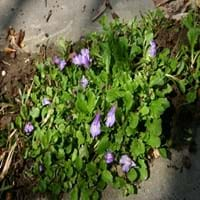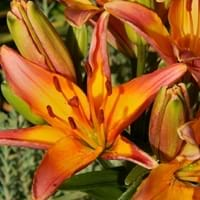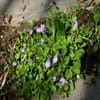Life Span
Perennial
Perennial
Type
Perennial
Bulb or Corm or Tuber
Origin
Southeastern Asia, Nepal
Hybrid origin
Types
Not Available
Not available
Habitat
Coastal Regions, Cold Regions, Terrestrial
subtropical regions, Temperate Regions
USDA Hardiness Zone
5-8
4-8
Sunset Zone
1a, 1b, 2a, 2b, 3a, 3b, 4, 5, 6, 7, 8, 9, 14, 15, 16, 17, 18, 19, 20, 21, 22, 23, 24
21,22
Habit
Mat-forming
Upright/Erect
Flower Color
White, Blue Violet
Gold, Pink
Flower Color Modifier
Bicolor
Bicolor
Fruit Color
Not Available
Green, Brown
Leaf Color in Spring
Green
Green, Dark Green
Leaf Color in Summer
Green
Light Green
Leaf Color in Fall
Green
Several shades of Green
Leaf Color in Winter
Light Green
Light Green
Leaf Shape
Lance shaped
Lanceolate
Plant Season
Spring, Summer, Fall, Winter
Spring, Summer
Sunlight
Full Sun, Partial Sun, Partial shade
Full Sun, Partial Sun
Type of Soil
Loam, Sand
Clay, Loam, Sand
The pH of Soil
Neutral
Acidic, Neutral
Soil Drainage
Well drained
Well drained
Bloom Time
Late Spring, Early Summer, Summer
Early Summer, Summer
Tolerances
Drought
Drought
Where to Plant?
Ground
Ground, Pot
How to Plant?
Seedlings
Bulbs
Plant Maintenance
Low
Medium
Watering Requirements
Average Water Needs, Do Not over Water, Never Over-water, Requires regular watering
Average Water Needs
In Summer
Lots of watering
Lots of watering
In Spring
Moderate
Moderate
In Winter
Average Water
Average Water
Soil pH
Neutral
Acidic, Neutral
Soil Type
Loam, Sand
Clay, Loam, Sand
Soil Drainage Capacity
Well drained
Well drained
Sun Exposure
Full Sun, Partial Sun, Partial shade
Full Sun, Partial Sun
Pruning
Prune if you want to improve plant shape, Remove damaged leaves, Remove dead leaves
Remove damaged leaves, Remove dead branches, Remove dead leaves
Fertilizers
fertilize in growing season, Less fertilizing
All-Purpose Liquid Fertilizer
Pests and Diseases
Insects
Red blotch
Plant Tolerance
Cold climate
Drought
Flower Petal Number
Single
Single
Foliage Texture
Fine
Medium
Foliage Sheen
Matte
Glossy
Attracts
Butterflies, Insects
Hummingbirds
Allergy
Asthma
Not Available
Aesthetic Uses
Beautification, Ground Cover, Landscape Designing, Showy Purposes, Used for decorating walls, fences, gates, hedges, etc.
Beautification, Bouquets
Beauty Benefits
Not Available
Not Available
Environmental Uses
Air purification, Food for insects, No fertilizer, pesticides, or herbicides needed, Prevent Soil Erosion
Air purification
Medicinal Uses
Cough
Not Available
Part of Plant Used
Whole plant
Flowers
Other Uses
Decoration Purposes, Employed in herbal medicine, Showy Purposes
Showy Purposes
Used As Indoor Plant
No
No
Used As Outdoor Plant
Yes
Yes
Garden Design
Alpine, Edging, Groundcover, Rock Garden, Wall
Container, Cutflower, Feature Plant, Mixed Border
Botanical Name
MAZUS reptans
LILIUM 'Ladylike'
Common Name
Creeping Mazus
Asiatic Lily, Ladylike Lily
In Hindi
जीव Mazus
Ladylike lily
In German
Creeping Mazus
Ladylike lily
In French
Creeping Mazus
Ladylike lily
In Spanish
arrastramiento Mazus
Ladylike lily
In Greek
υφέρπουσα Mazus
Ladylike lily
In Portuguese
Creeping Mazus
Ladylike lily
In Polish
Creeping Mazus
Ladylike lily
In Latin
reptilia Alba
Ladylike lily
Phylum
Anthophyta
Not Available
Class
Dicotyledonae
Liliopsida
Order
Scrophulariales
Liliales
Family
Scrophulariaceae
Liliaceae
Clade
Angiosperms, Asterids, Eudicots
Angiosperms, Monocots
Tribe
Mimuleae
Not Available
Subfamily
Mimuloideae
Not Available
Number of Species
Not Available
Properties of Creeping Mazus and Ladylike Lily
Wondering what are the properties of Creeping Mazus and Ladylike Lily? We provide you with everything About Creeping Mazus and Ladylike Lily. Creeping Mazus doesn't have thorns and Ladylike Lily doesn't have thorns. Also Creeping Mazus does not have fragrant flowers. Creeping Mazus has allergic reactions like Asthma and Ladylike Lily has allergic reactions like Asthma. Compare all the properties and characteristics of these two plants. Find out which of these plant can be used as indoor plant. If you are interested to decorate your house and garden, find out aesthetic uses, compare them and select the plant which will beautify your surrounding. Along with beautification, try comparing medicinal and edible uses of Creeping Mazus and Ladylike Lily and you can choose the plant having best and most benefits.
Season and Care of Creeping Mazus and Ladylike Lily
Season and care of Creeping Mazus and Ladylike Lily is important to know. While considering everything about Creeping Mazus and Ladylike Lily Care, growing season is an essential factor. Creeping Mazus season is Spring, Summer, Fall and Winter and Ladylike Lily season is Spring, Summer, Fall and Winter. The type of soil for Creeping Mazus is Loam, Sand and for Ladylike Lily is Clay, Loam, Sand while the PH of soil for Creeping Mazus is Neutral and for Ladylike Lily is Acidic, Neutral.
Creeping Mazus and Ladylike Lily Physical Information
Creeping Mazus and Ladylike Lily physical information is very important for comparison. Creeping Mazus height is 250.00 cm and width 30.50 cm whereas Ladylike Lily height is 35.60 cm and width 25.40 cm. The color specification of Creeping Mazus and Ladylike Lily are as follows:
Creeping Mazus flower color: White and Blue Violet
Creeping Mazus leaf color: Green
Ladylike Lily flower color: Gold and Pink
- Ladylike Lily leaf color: Green and Dark Green
Care of Creeping Mazus and Ladylike Lily
Care of Creeping Mazus and Ladylike Lily include pruning, fertilizers, watering etc. Creeping Mazus pruning is done Prune if you want to improve plant shape, Remove damaged leaves and Remove dead leaves and Ladylike Lily pruning is done Remove damaged leaves, Remove dead branches and Remove dead leaves. In summer Creeping Mazus needs Lots of watering and in winter, it needs Average Water. Whereas, in summer Ladylike Lily needs Lots of watering and in winter, it needs Average Water.





